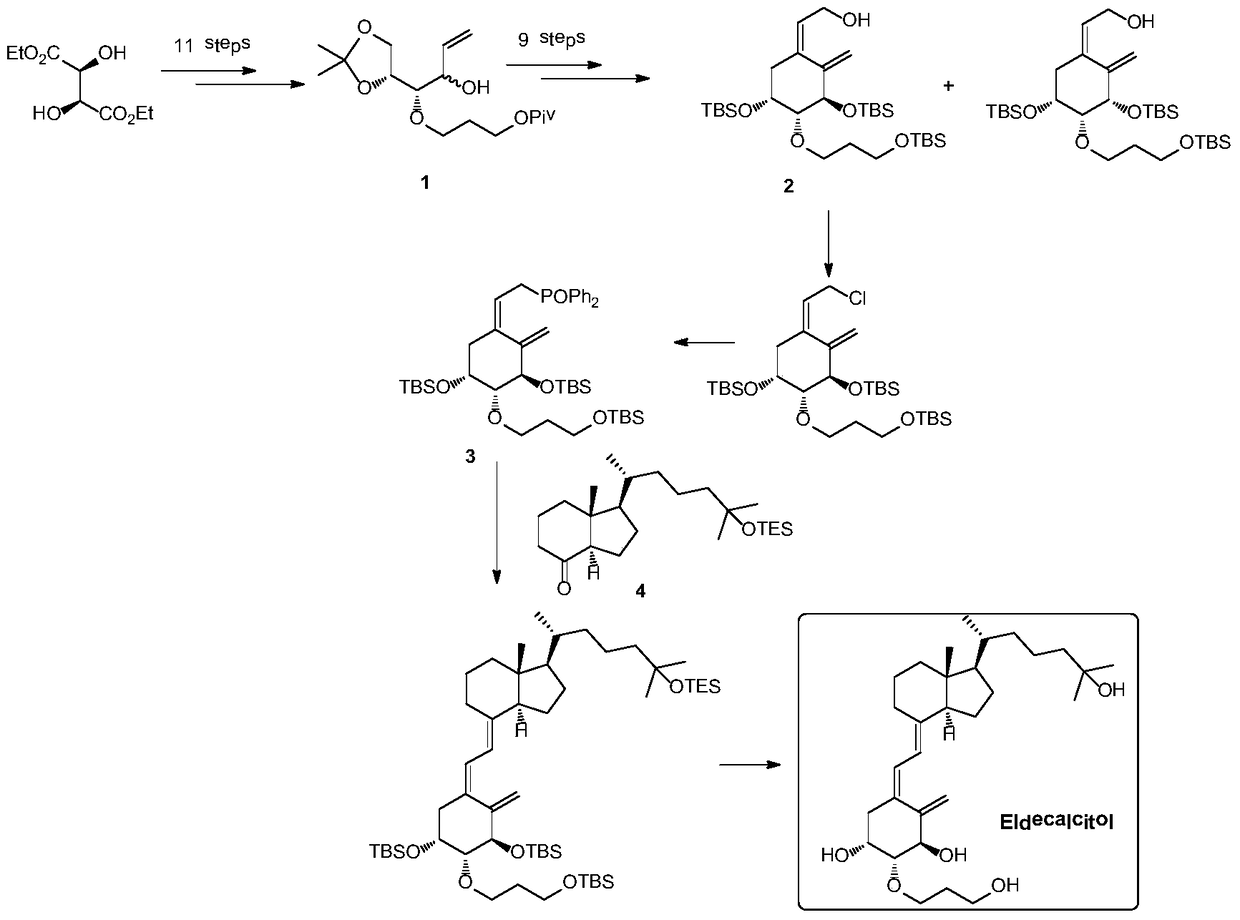A kind of preparation method of alcalcidol intermediate
A technology of saponification and compounding, which is applied in the field of preparation of alcalcitol intermediate 1A, can solve the problems of low raw material utilization rate, influence on product quality, increased workload, etc., and achieve the effect of easy industrial scale-up and improved raw material utilization rate
- Summary
- Abstract
- Description
- Claims
- Application Information
AI Technical Summary
Problems solved by technology
Method used
Image
Examples
Embodiment 1
[0033] Example 1 Preparation of Compounds 1A and 7 from Compound 1
[0034]
[0035]Compound 1 (33 g, 100 mmol) and ethyl acrylate (20 g, 200 mmol) were dissolved in 500 mL of n-hexane, Novozymes lipase 4353 g was added at room temperature, heated to 70 ° C, kept the temperature to react overnight, sampling and filtration HPLC detection, 1B Less than 3%, the reaction is completed. The solid was removed by filtration, the filter cake was washed with 200 mL of n-hexane, the filtrate was collected and concentrated to obtain 35 g of crude product. The crude product was subjected to silica gel column chromatography to obtain 17 g of compound 1A with a yield of 52% and a purity of 97%, and compound 716 g with a yield of 48% and a purity of 95%.
[0036] Compound 1A: 1H NMR (400MHz, CDCl3) δ=5.93 (ddd, 1H, J=17.4, 10.7, 6.2Hz), 5.34 (dt, 1H, J=17.4, 1.5Hz), 5.23 (dt, 1H, J= 10.2, 1.5Hz), 4.29–4.09 (m, 4H), 4.00 (dd, 1H, J=8.4, 6.3Hz), 3.79–3.65 (m, 3H), 3.30 (dd, 2H, J=6.0, 5.0H...
Embodiment 2
[0040] Example 2 Preparation of Compound 1B
[0041]
[0042] Compound 7 (15 g, 40.3 mmol) was dissolved in 100 mL of tetrahydrofuran and 100 mL of methanol, and potassium carbonate (11.1 g, 80.6 mmol) was added under cooling to zero. After the addition, the temperature was naturally raised to room temperature for 3 hours. The reaction was completed until the spots of the raw materials were detected by TLC, and the reaction was completed. The reaction was quenched by adding 300 mL of water. Extracted three times with 100 mL of ethyl acetate, combined the organic phases, washed with 200 mL of saturated brine, dried with 200 g of anhydrous Na2SO4, and concentrated to obtain 14 g of crude product. The crude product was chromatographed on a silica gel column to obtain 12.5 g of compound 1B with a yield of 93.9% and a purity of 95%.
[0043] 1B: 1H NMR (400MHz, CDCl3) δ=5.89 (ddd, 1H, J=17.4, 10.7, 6.2Hz), 5.35 (dt, 1H, J=17.4, 1.5Hz), 5.24 (dt, 1H, J=10.2 ,1.5Hz),4.29-4.09(m...
Embodiment 3
[0045] Example 3 Preparation of Compound 1C
[0046]
[0047] Compound 1B (10 g, 30.4 mmol) was dissolved in 100 mL of dry THF, triphenylphosphine (31.8 g, 121.6 mmol), and p-nitrobenzoic acid (20.3 g, 121.6 mmol) were added, and the temperature was lowered to zero in batches. DEAD (21.0 g, 121.6 mmol) was added, and the mixture was allowed to warm to room temperature and stirred for 3 hours. The reaction was carried out until the spot of the raw material disappeared as observed by TLC, and 300 mL of water was added to quench the reaction. Extract with 100 mL of ethyl acetate three times, combine the organic phases, wash with 200 mL of saturated brine, dry with 200 g of anhydrous Na2SO4, and concentrate to obtain 44 g of crude product. The crude product was subjected to silica gel column chromatography to obtain 13.5 g of compound 1C with a yield of 90.9%.
[0048] 1H NMR (400MHz, CDCl3): δ=8.40-8.20 (4H, m), 6.8-6.74 (1H, m), 6.43-6.37 (1H, dd, J=1.5, 17.37Hz), 5.80-5.76...
PUM
 Login to View More
Login to View More Abstract
Description
Claims
Application Information
 Login to View More
Login to View More - R&D
- Intellectual Property
- Life Sciences
- Materials
- Tech Scout
- Unparalleled Data Quality
- Higher Quality Content
- 60% Fewer Hallucinations
Browse by: Latest US Patents, China's latest patents, Technical Efficacy Thesaurus, Application Domain, Technology Topic, Popular Technical Reports.
© 2025 PatSnap. All rights reserved.Legal|Privacy policy|Modern Slavery Act Transparency Statement|Sitemap|About US| Contact US: help@patsnap.com



